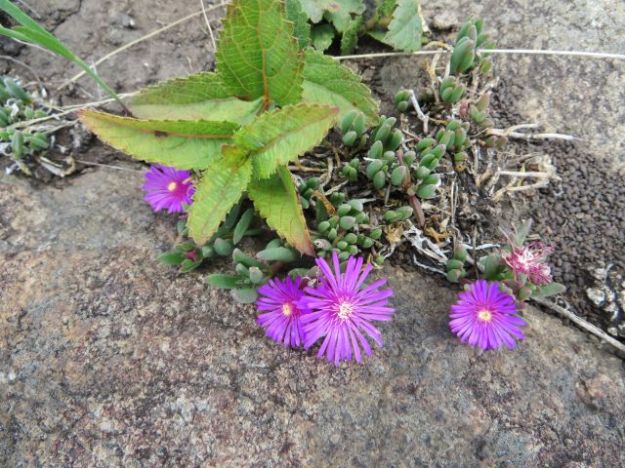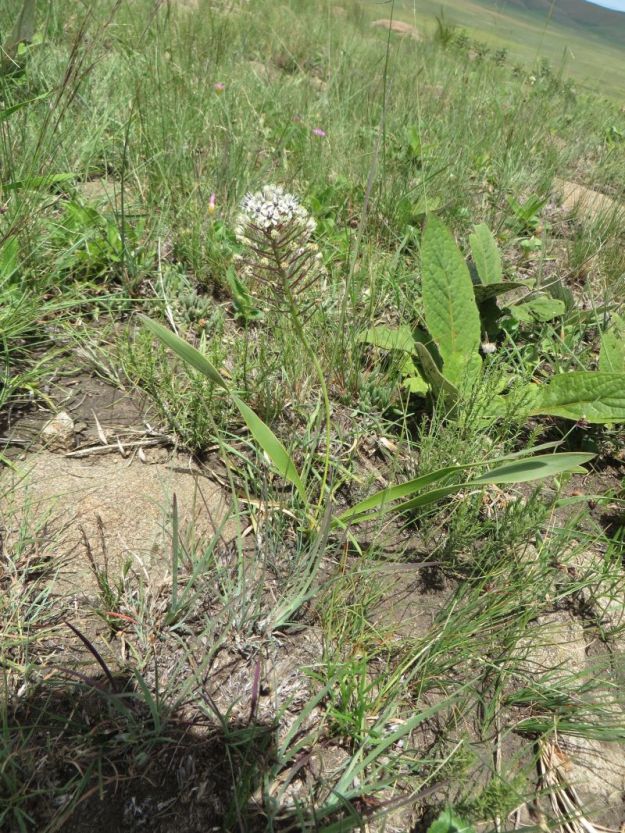CREW fieldtrips are seldom dull. Kathy Milford compiled this report on a recent excursion:
The 4x4s packed with 10 wild flower lovers, wound their way up a steep hill to Lake Lyndhurst past magnificent indigenous forests dotted with Calodendron capense in full bloom. We passed many clumps of Dierama latifolium.
Kobus Kruger who has a thatched home on the lakeside then led us past the lake where we saw a beautiful dark red Brunsvigia natalensis, just before we left the beaten track.
The 4x4s bumped and jolted their way over the boulder strewn mountainside up to the top of the escarpment, with a quick stop to look at the white Craterocapsa tarsodes.
The view from the top was spectacular. 
We looked down onto the vlei which is the source of the life giving uMngeni river.
The mountaintop of Drinkkop stood next to us. We were surrounded by beautiful flowers between the boulders in the grassland. The bright pink Delosperma lavisiae contrasted beautifully next to yellow Lotononis.
The dainty little white flowers of Sutera floribunda peeped between the rocks. A Stachys kuntzei was in full bloom.
A most delicate white Felicia was blooming and Rhus discolor was in berry.
Jamesbrittenia breviflora spread along the ground
and Indigofera woodii bloomed next to a rock. Helichrysum appendiculatum looked like a professionally made posy!
Scilla nervosa,
Tulbaghia natalensis, Oxalis and a beautiful Moraea sp were blooming close together.
Some distance away the eye catching Pelargonium luridum stood tall.
But we had orchids to find, so we climbed into the 4x4s to make our way down the hill to a vlei between Drinkkop and Lake Lyndhurst. We had a quick stop to admire a Disperis cardiophora which has an extraordinary rich spicy scent – enticing us to get down on our hands and knees to smell it.
A bright little Argyrolobium was blooming nearby.
We arrived at the vlei and blooming on the side of a dry looking bank was a black Corycium dracomontanum or nigrescens orchid.
We walked down into the vlei passing Monsonia attenuata,
Wahlenbergia and Monopsis.
The vlei was unbelievably full of orchids. 
The white Satyrium trinerve were blooming in their hundreds and were the first to catch ones eye.
In between were dozens of Satyrium longicauda.
There was a single orange Disa chrysostachya looking like a poker.
The Disa rhodantha were a rich pink
and the brightest yellow Schizochilus zeyheri were blooming prolifically in between the tall grasses.
There was one lonely potential Disa scullyi which was past its prime and which Benny Bytebier too back to the herbarium to confirm its identity. Yes! it is Disa scullyi – at last we found one!
Having saturated ourselves with the numbers and varieties of orchids we made our way back to the house next to the lake to recharge. We had made a brief stop en route to look at an extraordinary Disa versicolor.
After lunch we set off home. A short stop at a little vlei on the way out of the Bravazulu estate did not yield any new orchids but there were little insectivorous Drosera natalensis glistening in the sunlight at the edge.
One lady got stuck up to her knees in mud in the vlei, with water overflowing from her gumboots and was pulled out by Benny before she was swallowed up by the mud!
The weather was kind to us – a bright blue sky with white fluffy clouds was replaced with dark grey storm clouds which soon blew over, unlike the hailstorm which caused damage back in Pietermaritzburg.
Kobus Kruger was an excellent guide and host, and Suvarna “the Stig” Parbhoo turned out to be an expert 4WD driver! Thanks to Benny Bytebier for sharing his amazing orchid knowledge.





















Lovely canvas of wildflowers, nurtured in the stunning wetlands, that are healthy and beautiful; others on the grassy or rocky slopes. A well-chosen time of the year for so many blooms, given the strange variations in rainfall being experienced. But Lake Lyndhurst always has something extraordinary to offer and this record is most enjoyable
LikeLike
Wonderful! thank you – I’m reading this in icy London with not much greenery around!
LikeLike